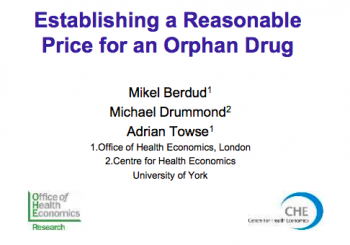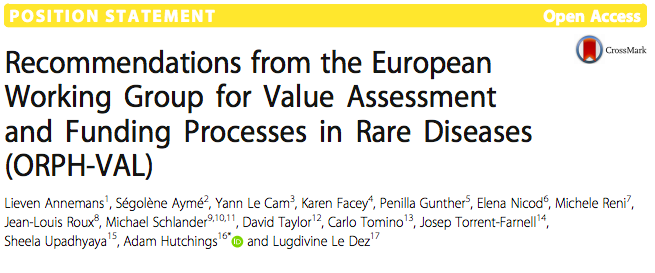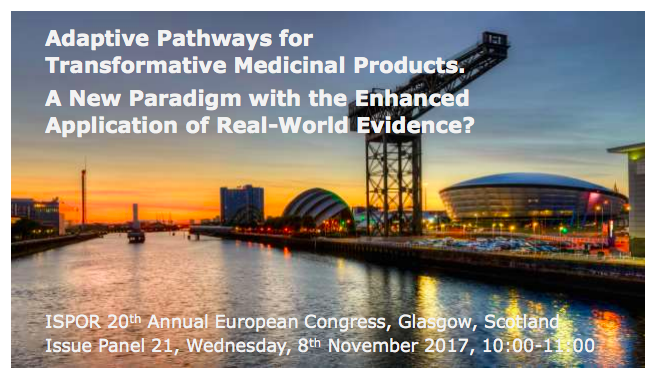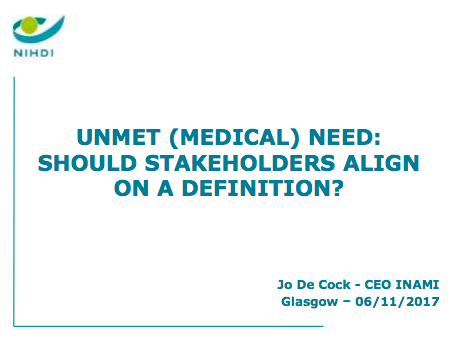Orphan Drugs Pricing and Sustainability
At a workshop entitled “Sustainable Funding and Fair Pricing for Orphan Drugs: What Are the Solutions?”, the panellists discussed the options that exist to make funding of valuable orphan medicinal products (OMPs) sustainable for healthcare systems while also providing ‘fair’ reward to manufacturers that invest in these areas of high unmet need.
Martina Garau, MSc, Principal Economist, Office of Health Economics, UK, provided an overview of the rate of Health Technology Assessment (HTA) approval and reimbursement of OMPs across Europe and concluded that there is still considerable variation in funding and provision of these across EU countries (access her presentation here).
Saskia Knies, PhD Senior Advisor Pharmacoeconomics, National Health Care Institute (ZiN), the Netherlands, provided insights from the current Dutch approach of assessing and appraising orphan drugs. Saskia Knies especially noticed that “willingness to pay” threshold (maximum Incremental Cost-Effectiveness Ratio, ICER) were modulated based on the burden of disease to the patient (access her Presentation here).
Michael Drummond, MCom, DPhil, Professor of Health Economics, University of York, UK proposed a new method that could be used to adjust the ICER threshold to reflect the differences between the population size and R&D costs of orphan and non-orphan treatments (access his Presentation here).
Orphan Drugs P&R – ‘ORPH-VAL’ Principles to Improve Consistency
An issue panel entitled “How to Improve Consistency of Orphan Drug Pricing and Reimbursement in Europe? Application of the ‘ORPH-VAL’ Principles in Germany, France, and the United Kingdom”, was moderated by, Lieven Annemans, PhD, MSc, Professor of Health Economics, ICHER, Ghent University—Brussels University, Belgium. Panellists included Karina Ehrig, PhD, Scientific advisor, Federal Joint Committee (G-BA), Germany; Sheela Upadhyaya, MSc, Associate Director, Centre for Health Technology Evaluation, Highly Specialised Technologies, NICE, UK; and Francois Meyer, PhD, Advisor to the President, International Affairs, HAS, France.
In Europe, rare diseases represent a major public health issue with high unmet need. The legislation on orphan drugs introduced in EU in 2000, has been successful in stimulating investment in the research and development of these. Patient access to these medicines, however, is imperfect. Access varies partially due to Pricing and Reimbursement (P&R) challenges with orphan drugs and the different approaches toward access by country.
The European Working Group for Value Assessment and Funding Processes in Rare Diseases, ORPH-VAL, a multistakeholder group of rare disease experts, patient representatives, academics, health technology assessment (HTA) practitioners, politicians and industry representatives in Europe, published a set of principles for value assessment and funding processes in rare diseases in March 2017 (access publication here). Speakers discussed how P&R for OMPs in Germany, France, and the UK align with these principles and the opportunities for improvement to ensure that the promise of Orphan Drugs’ is realised.
Access the presentation: here
Adaptive Pathways and Real-World Evidence (RWE)
Patients are often willing to accept greater risks from treatment of life-threatening diseases in return for earlier access. The rising influence of patient lobbies puts focus on rapid development and faster access to potentially transformative medicines. Better defined, smaller patient populations and the need for speed challenge established development pathways and regulatory, HTA and pricing systems.
In response, paradigms of biomedical innovation are being transformed with “Adaptive pathways”. In order to achieve equitable and timely access for patients with unmet needs, market access and reimbursement in step with earlier conditional marketing authorisation is essential.
However, uncertainty about whether the anticipated clinical benefits will be verified and the possibility of undiscovered risks pose challenges to HTA bodies. With greater uncertainty, a novel medicine’s price should no longer be determined at first market entry, but be governed by more flexible approaches that reflect the emerging evidence generated.
The panellists discussed how patient-centered RWE presents a significant opportunity to enhance early access regulatory decision-making and adaptive value-based contracting centred on mutually agreed outcomes and set milestones.
Nonetheless, opinions on RWE remain diverse. Ad Schuurman, Head of the International Department, National Health Care Institute (ZIN), Netherlands raised concerns regarding the methodology and reliability of RWE generated and noted that the decline in quality of evidence should be prevented.
Unmet Medical Need: Should Stakeholders Align on a Definition?
An issue panel entitled “Unmet Medical Need: Should Stakeholders Align on a Definition?”, was held and moderated by Claudine Sapede, PharmD, MSc, Hoffmann-La Roche, Switzerland (access her Presentation here). Panelists included Nicola Bedlington, European Patients’ Forum and The Patient Access Partnership, Belgium (access here the Presentation); Neil McAuslane, PhD, Center for Innovation in Regulatory Science, UK (access his Presentation here), and Jo De Cock, MS, INAMI, Belgium (access his Presentation here).
Addressing unmet medical need in drug development is a key criterion for medicine prioritisation. It is also one of the requirements a molecule candidate needs to satisfy in order to qualify for an adaptive pathways approach and a number of accelerated regulatory review processes, such as the MHRA Early Access to Medicines Scheme EAMS and the EMA Scheme, PRIME.
A common definition of the term “unmet medical need,” however, does not exist. The interpretation of the term may also vary between various stakeholder groups (e.g., regulators, payers, patients, medicine developers) and between countries. This inconsistency leads to significant challenges in achieving stakeholder alignment on a medicine’s eligibility for accelerated development and patient access pathways.
These issues have also been identified by the WHO and the European Parliament that have called on the EU Commission to define clearly the concept of unmet medical need, how this concept is interpreted and what criteria need to be fulfilled in order to identify unmet medical need and on stakeholders to explore new ways of delivering affordable medicines to patients.
The multistakeholder panel noted that more cooperation between regulatory and HTA bodies was particularly needed to ensure alignment on which medicines can be considered to fulfil high unmet medical need and on the clinical evidence requirements.
The panel presented various perspectives on how the interpretation of unmet medical need impact P&R decisions in health care systems. Jo De Cock, MS, National Institute for Health and Disability Insurance, INAMI, Belgium presented the Belgian Program that aims to prioritise innovative unmet medical need therapies by using a multi-criteria decision analysis (MCDA) approach to rank therapeutic and societal needs, taking the preferences of the general public into account (Access his Presentation here).
Access to all the released presentations of the congress : here





